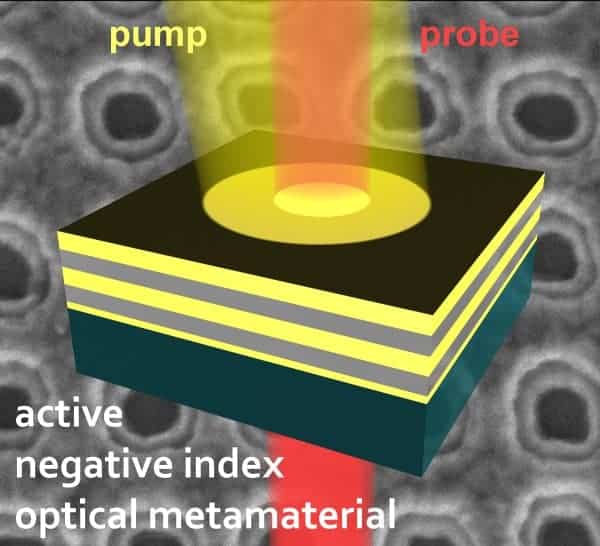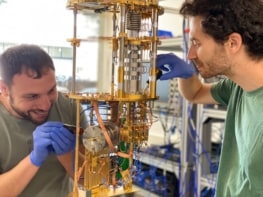
Physicists in the US have overcome a major problem that has plagued the designers of “invisibility cloaks” by creating the first negative-index metamaterial (NIM) with a built-in amplifier. It compensates for the strong absorption of light that occurs in optical NIMs, severely limiting their practical use.
Unlike naturally occurring materials, which have a positive index of refraction, a NIM has a structure that is engineered artificially to have a negative index of refraction. NIMs have a number of desirable properties that do not exist in normal materials, including the ability to focus light to a point smaller than its wavelength in a so-called “hyperlens”. Such a device could allow optical microscopes to view much smaller objects than possible today.
NIMs that work at optical wavelengths do have one major drawback – their metal components absorb most of the light that passes through them. One way of getting around this is to incorporate “active” materials such as laser dyes onto the surface of the metamaterial, but physicists have struggled to make this work. Now, however, Vladimir Shalaev and colleagues at Purdue University have found a way around the absorption problem by incorporating a fluorescent dye within the insulating component of their NIM.
Dye in the hole
Their new design is based on the “fishnet” NIM, which Shalaev has been studying in his lab for several years. The structure comprises a layer of alumina sandwiched between two layers of silver – each layer being 50 nm thick. The layers are punctured with oval-shaped holes that are about 200 nm across and repeat every 280 nm in a square array that resembles a net.
The team created the active NIM by etching away much of the alumina, leaving only thin pillars to prevent the structure from collapsing. The resulting gaps were then filled with an epoxy film containing the fluorescent dye Rhodamine 800 (Rh800).
Pump and probe
When these Rh800 molecules are “pumped” with a pulse of 690–nm–wavelength light, they will emit light around 730 nm for several nanoseconds after the pulse is over. If a “probe” pulse of light at about 730 nm is fired at the dye during this time, it will stimulate the emission of light from the dye. The stimulated light is identical to the probe light, the result being the amplification of the probe pulse.
Shalaev and team hoped that amplification by the active epoxy layer would overcome the absorption losses in their NIM. To confirm this they did a “pump-probe” experiment where they fired a 2–ps–long pump pulse at the NIM followed by a 50 ps delay and then a 2 ps probe pulse. The absorption, reflectance and transmission of the probe light by the NIM were measured and the experiment was then repeated without a pump pulse.
The team found that the absorption coefficient of the pumped NIM was about a million times smaller than when no pumping occurs. Indeed, at probe wavelengths of 722–738 nm the combined intensity of the transmitted and reflected light was actually greater than that of the probe pulse – proving that the NIM is working as an amplifier. Metamaterial expert Ulf Leonhardt of St Andrews University in Scotland described the work as a “tremendous achievement”.
Exotic prospects
Shalaev told physicsworld.com that active NIMs could be used to create exotic optical devices including hyperlenses – which can image objects much smaller than is possible using an optical microscope – and nanoscale waveguides that can transmit light with no losses. The technology could even be used to create cloaking devices that bend light around an object, concealing its presence to an observer.
The team’s next goal is to replace the dye with a semiconductor material that can be pumped using an electrical, rather than optical signal. An electrically-driven device would be much easier to integrate with conventional optoelectronics. However, Shalaev believes that optically driven NIMs could also find practical applications.
The work is reported in Nature 466 735.



